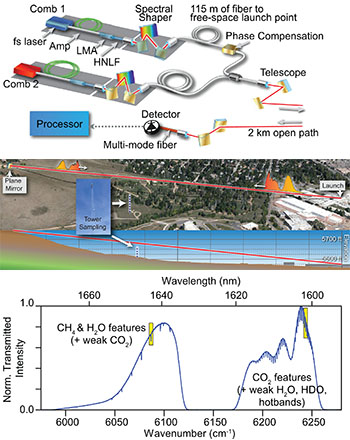
[Top and middle] The setup combines two frequency combs with spectra tuned to greenhouse gas absorption bands and launches them across a total distance of 2 km. [Bottom] Returned pulse shows smooth shape of original comb intensity profile, with dips of up to 15 percent at relevant methane, water vapor, and CO2 absorption lines. [Image: Adapted from Rieker et al., Optica 1, 290 (2014)]
This past weekend, the Intergovernmental Panel on Climate Change released its most sobering report to date, suggesting that greenhouse gas emissions must be cut to effectively zero by the end of this century to avoid “severe, pervasive and irreversible impacts for people and ecosystems.” But to understand greenhouse gases in the atmosphere, and to monitor compliance as nations move to roll back emissions, requires the ability to accurately measure changes in their concentration over long ranges. A group of U.S.-based scientists has now developed a frequency-comb-based method that can sense such changes across distances on kilometer scales (Optica, doi: 10.1364/OPTICA.1.000290).
The team looked to optical frequency combs to address several shortcomings of conventional absorption spectroscopy, the prevailing remote-sensing technique for evaluating changes in greenhouse gas concentrations at distance. One problem has been a lack of reproducibility and precision at the concentrations and wavelengths of interest for greenhouse gas species such as CO2 and methane. Another has been difficulty in fashioning truly portable instruments that can operate at length scales greater than a kilometer, essential for continuous, regional monitoring. In principle, dual frequency-comb spectroscopy (DCS)—which sports high signal-to-noise ratios (SNRs) across multi-kilometer distances, and for which portable comb sources are increasingly available—could resolve both shortcomings.
The researchers implemented their DCS system by combining two mutually coherent, erbium-doped-fiber frequency combs, with spectra centered around the “water window” near 1.6 µm and with the shape further tweaked to cover important absorption bands for methane and CO2. The result of the combination was an RF comb with a 444 Hz spacing, with approximately 40,000 comb-tooth pairs across the measured spectrum. Pulses of comb light were then launched across a 1 km distance, reflected by a 50 cm plane mirror, and returned to the point of origin, where they were detected and analyzed. The returned pulse showed the same broad, smooth shape of the original comb, but with abrupt and significant dips at the absorption lines for water vapor, CO2, and methane.
According to the paper, the results show that “the fundamental properties of DCS—namely high resolution, high accuracy, broad bandwidth, and high SNR—can be directly translated to field-based measurements.” Further, the system could be better equipped to handle a perennial problem of open-air spectroscopy, turbulence, because, in contrast to alternative methods, the acquisition time is brief enough to effectively “freeze” the inherently time-dependent effects of turbulence in the acquired signal. The team believes that the work could ultimately lead to a generation of low-cost, field-deployable sensors, capable of monitoring multiple gas species over multiple optical paths around the clock. That could prove a useful tool at a time of increasing focus on meaningful reductions in greenhouse gases.
